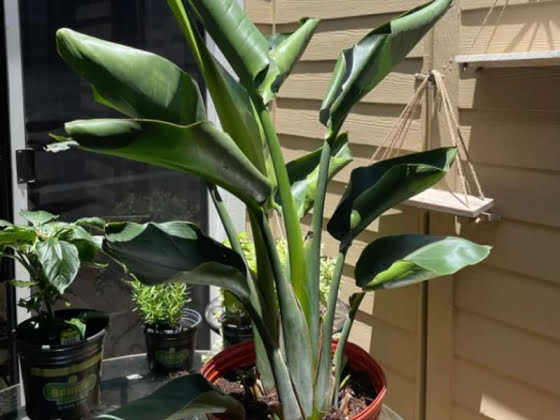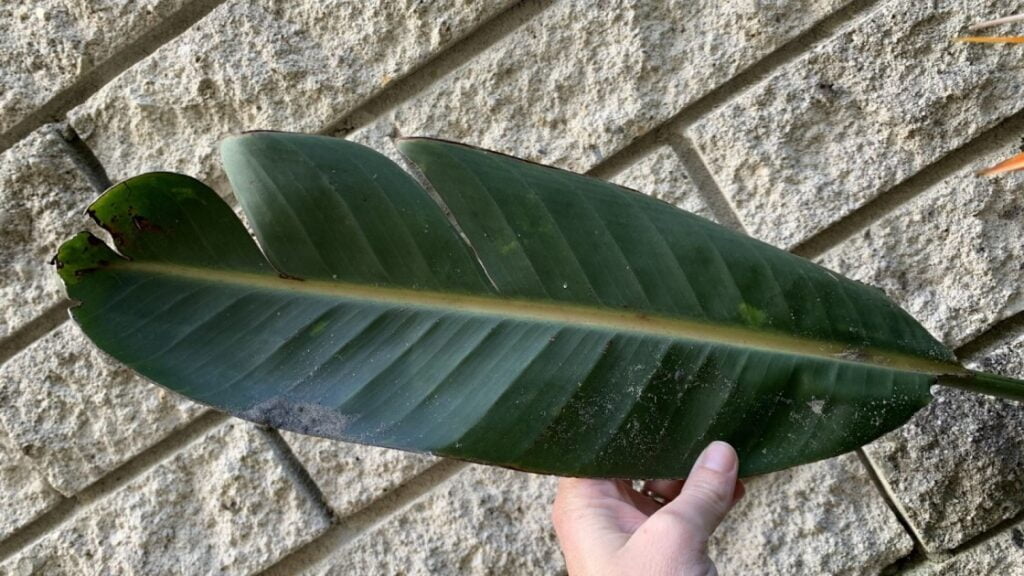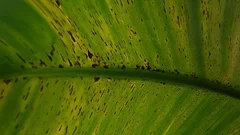
The bird of paradise is a tropical plant known for its huge leaves and striking yellow flower that looks like a tropical bird. Over the years I have witnessed its increasing popularity, but at the same time many owners reach out to us for advice with a common concerning issue, and it is none other than curling leaves of the plant.
So if you are facing the same problem, do not worry, you are not alone!
You might have queries like why are your birds of paradise leaves curling? and how do you fix it?
To answer all your queries I made this post. I will break down seven main factors that are responsible for curling leaves and give out solutions. Along will that I will discuss what is their ideal growing condition so that after reviving them back to health you can tend them the way your tree will appreciate.
What is the bird of paradise plant?
I know people who own the plant are already aware of all the characteristics of the plant, but if you are curious about the plant or planning to own one and landed here to prepare yourself beforehand to avoid the issue, this section is especially for you.
The bird of paradise is a tropical plant and is closely related to the banana plant. It got the name because its flower has a close resemblance to the tropical bird with the same name. Their flower emerges upright from the leaves making them look like a beautiful yellow bird sitting on the plant. This is the reason for its increasing popularity but also these plants are fairly easy to maintain if you compare it with other tropical plant species.
| Facts | Descriptions |
| Common name | Bird of Paradise, crane flower |
| Scientific name | Strelitzia reginae |
| Family | Strelitziaceae |
| Plant type | Herbaceous perennial |
| Height | 3.5-6 ft. tall |
| Leaves | 12 to 18 inches long leaves |
| Flower | Yellow or white |
| Bloom time | Early spring |
What does a healthy bird of paradise look like?
These plants are comprehended for their wide, paddle-like leaves and flashy, bright blossoms. The leaves are usually defined as being leathery. They extend to about 18 inches long and sit at the end of elevated leafstalks. Here’s a picture for reference;

[Bird of Paradise plant on sale]
What does “leaf curling” mean?
Birds of Paradise Leaves Curling typically means the edge of the leaves or the entire leaf has a rolled or curved formation. Leaves curl is a process to cope with excessive sun exposure, underwater, overwater, or other environmental stress. Let’s go through them one by one in detail.
7 reasons why Birds of Paradise leaves curling?
Does underwatering cause birds of paradise leaves to curl?
Dehydration is one of the primary reasons behind your birds of paradise leaves curling. These tropical plants have huge leaves and they use them to evaporate water every single day. Tropical plants naturally require constant moisture and the bird of paradise being a big-leafed plant requires even more. When they don’t get the needed moisture, they curl their leaves inwards from the edges to create a smaller area for less evaporation.
How to identify
Along with the edge curling you will also notice the tip and edges of the leaf are drying and wilting.
How to fix it?
- Water more often but correctly. It’s time to give them a drink if half or 2-3 inches of the upper surface of the soil feels dry.
- Use a fine nozzle can to water the plant, this way every single inch of the soil will be moist.
- The pots you will use should be equipped with drainage holes. When watering, the extra water should glide out via drainage holes swiftly, without retaining it for days.
- A humidity tray will help to moistness around the huge leaves of the bird of paradise.
[Buy watering can]
[Buy humidity tray]
Does overwatering cause leave curl?
One thing people mistake with tropical water-loving plants like birds of paradise is that they can stand any level of water. It’s true when I said these trees love water, but they hate it when the water in the soil keeps it moist constantly or for a longer period of time. Underwatering gives the tree a stressful survival situation but overwatering will straight up rot the roots and kill them, Leaf curling is just a little side symptom. I have observed overwatering is more common when the plant is living indoors.
How to identify
Leaves curl outwards and turn yellow from stem to tip.
How to fix
- Take the Bird of Paradise out of the container and examine the roots. If decay is visible, wash the roots from the soil and clean them properly.
- Employ a clean pruning tool like shears to remove all diseased tissue and spray with a fungicide to prevent the rot from spreading any further.
- Re-pot the Bird of Paradise in a container with drainage holes. The soil should be easy-drained and free of pathogens.
- After you see any signs of recovery, you can use the watering techniques I have mentioned in the previous section.
Note:
It’s not a vital point that’s why I didn’t include it in the main list, but water quality can also be a cause of birds of paradise leaves curling. The tap water you use might contain some chemicals that are not adaptable to the plant. If the substance reaches the leaves it can curl itself out of rejection.
To make the leaves flare at their full glory start using filtered water or if you are out of options, fill the tap water in a tub, let it sit for twenty-four hours, and use it on your plant.
Do birds of paradise leaves curling up due to the sun?
Typically birds of paradise plants are known as sun-loving plants, they can consume several hours of sun every day. But when the sun exposure is extreme and constant it closes in order to prevent themselves from sunburn.
When the plant is cultivated indoors and all of a sudden receives unfiltered sun, the atmospheric fluctuation makes them sensitive and to cope with it they start to curl.
How to identify
You will notice small dark burning spots all over the leaves.
How to fix
- Move the plant indoors, especially in mid-summer, and place it near your east or west-facing window. Use your curtains to make the sunlight even more filtered and gradually increase the sunlight. Observe the tree along the process to determine its healthiest phase, this way you will understand what is the ideal sunlight for your plant.
- Increase the amount of water slightly for quick recovery.
Tips:
If you notice any completely dried-up curled leaves, it may not recover, so better trim it out and give other parts of the plant your utmost attention.
Is transplant shock the reason behind the Birds of Paradise leaves curling?
I have mentioned earlier that re-potting is needed if the plant is curling from overwatering, but if it doesn’t receive an ideal environment after re-potting or getting exposed to the harsh environment all of a sudden, the plant will get into its transplanting shock phase. The plant will show symptoms through wilting and curling its leaves but if you ignore it it will end up dying.
How to identify
Along with curling and wilting, there will be yellowing of the tissue between the veins of the leaves.
How to fix
- Do not transplant when they are most active, particularly avoid growing seasons spring and autumn.
- Keep the newly transplanted plant in the shade for a couple of weeks and gradually increase the amount of sun and water it receives.
How Soil quality can affect the birds of paradise leaves curling?
The soil quality can highly affect the curling of the leaves of birds of paradise. If the soil is too alkaline the plant will have a hard time absorbing microelements from the soil and as a result, it will develop chlorosis. Lack of nutrients in the soil forces the plant to close their leaves in a curling formation.
How to identify
The curling will be inwards and the leaves will turn yellow with green veins.
How to fix
- The plant will need ideal soil conditions for a whole growing season to recover.
- Add more compost to the soil. Compost will make the soil more acidic and will reduce chlorosis.
- Give slow-release fertilizer once a year in between growing months.
How Pests and diseases are responsible for leaves curling?
Some pests and diseases can curl the leaves with different processes, for example, let’s talk about the common intruder of every plant, spider mite. These sap-sucking tiny creatures left the spot after sucking, fluidless, and as a result, the leaf start to curl.
Some diseases also can make the leaves dry and force them to curl and wilt.
How to identify
Pests can be detected with keen observation, for example, spider mites have small webbing all over the leaves and stems. Diseases usually leave brown spots.
How to fix
- Wash Bird of Paradise after placing them under the sink. Since mites do not like dampness, from time to time these kinds of shower is sufficient to get rid of them.
- If the mites don’t leave then you need to sprinkle the plant with neem oil or soapy water.
- Use multipurpose fungicides to combat infections.
How Small root system affect leaves curling?
As the plants grow it requires a bigger place to live, but many plant owners fail to realize the worth of re-potting. To survive and keep their growth intact the root system of birds of paradise starts coiling over each other, making a ball-like shape. At first upper part of the tree grows normally but the lower parts continue to live in compact space and shape. Gradually the roots fail to supply needed water and nutrients to the upper part of the tree. At this stage, the leaves curl themself to compact their size to combat the situation.
How to identify
Along with the curled-up leaves, you will notice them getting dry and yellow.
How to fix
- Select a size container where the roots can grow freely for the next one to two years.
- Check the drainage holes from time to time, if the roots are peeking from there.
- Other than that follow the guide I have mentioned in the transplantation shock section.
Key takeaways in a table format:
| Chlorosis in the leaves and curled leaf | How to detect the issue? | How to fix it? |
| Underwatering | Leaf curl and dry edges | Increase the frequency of watering and use a fine nozzle can water the plant. |
| Overwatering | Outward leaf curl and yellow leaves. | Decrease the frequency and make the soil more draining. |
| Sunlight | Leaf curl with burnt spots | Move the tree near a sunlit window and increase the amount of light gradually. |
| Transplant shock | Wilting and curling leaves | Keep the plant in the shade for at least two weeks and do not transplant in spring. |
| Soil | Chlosis in the leaves and curled leaf | Add compost to make the soil acidic. |
| Pests and disease | Visible insects and brown spots along with curling leaves. | Use insecticide or fungicide. |
| Small root system | Curl, dry, and yellow leaves. | Transplant the plant in a slightly bigger pot. |
Some other common issues your birds of paradise might be facing:
Leave splitting:

Leaf splitting is actually normal and doesn’t do any harm to the tree. In the wild leaves of birds of paradise normally split due to animals or weather. When they are cultivated as a houseplant, split leaves have an effect on their ornamental value.
How to fix it?
Avoid places with high temperatures or dry wind where it can dry up the leaves and split them.
Yellow Leaves:

The lower and matured leaves usually turn yellow first, which is an indication of imbalance. Most frequently, like hibiscus leaves the problem is generated by overwatering or under-fertilizing the plant.
How to fix it?
Feed your bird of paradise plant in the growing season with half-strength fertilizer and water only when the soil feels dry to the touch.
Brown Spotty Leaves:

Brown spots can be generated by a number of problems. Some of the more typical reasons are plenty of natural sunlight, excessive fertilization, fungal disease, and pests.
How to fix it?
Examine your bird of paradise and your maintenance habit to decide the reason for the brown marks; then you can treat the plant properly.
What’s the ideal growing condition of the Birds of Paradise plant?
Watering:
Generally, they require daily watering in summer and spring, other than that focus on the soil to keep it moist but don’t let it get water clogged or sit in a pool of water.
Ideal Temperature:
Try to keep the temperature above 60 degrees Fahrenheit. Birds of paradise plants are not cold hardy so they need protection from frost.
Right Humidity:
Being tropical plants they thrive in humidity. You can keep a spray bottle with you and mist the leaves now a then.
Right Soil:
Use rich, quick-draining soil with added compost.
Conclusion
I’m confident that your birds of paradise will return to their healthiest self if you follow the article to detect the issue. Cure your plant and give it the ideal growing condition it deserves. If you have noticed some other symptoms in your plant reach out to us, we will be happy to help.
